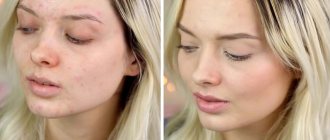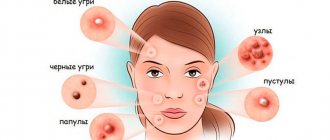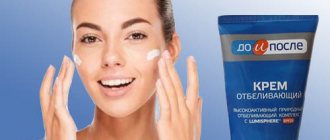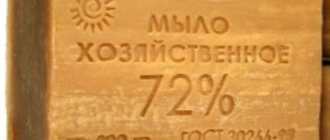- 21581
- 09-10-2020
- Author: Mysekret Team
- 1
Women and girls often face the problem of sudden redness on their face. This could be a reaction to cosmetics, improper cosmetic care, dermatitis and many other problems. In order to properly eliminate such a reaction, it is necessary to find out the cause when visiting a dermatologist. This is necessary to exclude serious diseases.
If the causes of redness are not related to dermatological problems, then a high-quality cream can not only mask the redness, but also cure it. The most important thing is to choose the right cream or foundation with a healing effect that suits your skin type.
Causes of redness on the face and body
Conditions that cause redness of the skin are divided into physiologically determined and pathological. In the first case, we are talking about normal conditions that do not indicate a particular disease. In the second case, redness of the skin may be a sign of a pathological process.
Among the physiologically determined prerequisites for skin redness are:
- Reaction to low or high ambient temperature.
- Redness of the skin caused by joy, embarrassment, shame.
- Performing physical activity.
Among the causes of pathological hyperemia of the skin are the following:
- Allergic reactions.
- Dermatological diseases.
- Systemic diseases.
- Infectious diseases.
- Cuperosis.
- Increased body temperature, high blood pressure.
- Reactions to stress.
- Side effect of certain medications.
- Reactions to an insect bite.
Preventive measures: how to prevent the development of rosacea?
Removing rosacea and fighting it is a long, troublesome task and involves vascular therapy. How to minimize the occurrence of rosacea. The rules are simple:
- try not to go outside in low temperatures and strong winds;
- minimize sun exposure or use a sun protection factor;
- do not visit baths and saunas;
- tune in to dietary nutrition, excluding spices, alcohol, hot dishes and drinks;
- do not take risks and refuse traumatic cosmetic procedures;
- act on the skin gently and delicately, focusing on cleansing and moisturizing;
- avoid excessive physical activity.
But rosacea can also occur for other reasons. A competent approach, a good dermatologist and properly structured therapy are the cornerstones in the treatment of rosacea.
Long-term treatment is aimed at strengthening the condition of blood vessels and relieving inflammatory manifestations. After therapy, you should apply the recommended medications to your skin for several months and adjust your lifestyle. Usually women do everything necessary to restore their original appearance and fair, blemish-free skin.
What is better: ointment or cream for redness on the face?
The choice of external remedy to eliminate redness should be based on the causes of hyperemia and the presence of accompanying symptoms. For example, if erythema is caused by an inflammatory process affecting the deeper layers of the skin, it is recommended to use ointment. It ensures deeper penetration of active components into the skin. The same applies to treating excessively dry, reddened areas of the skin. However, if redness of the skin is accompanied by the presence of weeping wounds, the use of ointments is not recommended.
Cream for skin redness is usually used in cases where it is necessary for the product to be absorbed as quickly as possible and not leave a sticky or greasy film on the skin. Usually the cream is used for application to the face.
How to get rid of redness from rosacea
The beautiful name “rosacea” conceals a rather unpleasant disease, the manifestation of which is expressed “on the face”. It is on the face that redness of an incomprehensible nature occurs. Sometimes they appear after going to the bathhouse, walking on a sunny day, after jogging or drinking alcohol. The reasons are different, but there is one sign – redness. Sometimes it gradually goes away, then appears again. And over time it becomes a “constant companion.” What causes the disease and how to remove rosacea on the face: this is the question that worries us today.
Cream for redness on the face and body: list of popular ingredients
The composition of products designed to combat redness on the nose, cheeks, neck and other parts of the body may vary. Common components include:
- Hyaluronic acid. Many creams for sensitive skin prone to redness contain hyaluronic acid. This substance helps moisturize the skin, stimulates the renewal of damaged cells, takes part in the production of collagen and elastin, and has anti-inflammatory properties.
- Collagen. In addition to the fact that this protein complex is necessary to maintain skin tone and elasticity, it also affects its pigmentation. A lack of natural collagen leads to discoloration of the skin.
- Panthenol. Panthenol is an essential component of most soothing face creams against redness. Absorbed into the skin, it is converted into pantothenic acid, which has a huge effect on skin regeneration, reducing inflammation and redness.
- Glycolic acid. This substance has a positive effect on cellular renewal processes, helps normalize the color of the skin, making it softer and more elastic.
- Allantoin. Allantoin is known for its regenerating, bactericidal and antioxidant properties. This substance evens out skin color, perfectly moisturizes and nourishes it, relieves irritation and redness.
- Glycerol. Many creams for redness and flaking of facial skin contain glycerin. This substance helps soften and moisturize the skin. Because of this, glycerin is often used to combat redness that appears on dry and sensitive skin.
- Plant extracts, base and essential oils. Plant components perfectly soothe irritated skin, relieve inflammation and normalize skin color. External products may include white and green tea, extracts of chamomile, calendula, aloe vera, shea butter, jojoba, wheat germ, almond, olive and castor, as well as essential oils of tea tree, lavender, mint.
- Bee products. Royal jelly, propolis, honey - they all have a positive effect on the condition of the skin. They contain a huge list of valuable amino acids, vitamins and minerals. This is why creams against redness on the face often contain beekeeping products. However, it must be borne in mind that they can cause allergies, so such products are not recommended for people who are hypersensitive to honey.
- Cosmetic clay. The cream for red spots on the face may contain cosmetic clay - white, pink, blue, green, black. Each type of clay has its own properties and characteristics, but almost all of them help reduce inflammation and even out skin color.
Physiotherapy
Physiotherapeutic procedures are carried out in parallel with therapeutic effects.
Laser exposure
Laser pulses tone blood vessels and restore blood circulation. Already after the first procedure, the effect is noticeable - reduced redness and a healthier complexion.
The method works as follows: the laser beam acts on all manifestations of rosacea without damaging deeper, healthy tissues.
Laser exposure is carried out after drug therapy, when correction of spider veins or other vascular problems is needed. This physiotherapy procedure can remove skin defects during remission. It is repeated once every 2 weeks with a total number of sessions from 3 to 7.
Note: The laser is not used at the acute stage, when inflammation is severe and dry skin is noticeable. Exposure to a laser beam can make the situation worse.
After completing the full therapeutic course, the patient’s blood vessels are strengthened, swelling and redness are relieved, the number of skin rashes is reduced or eliminated, and itching goes away. This leads to improved quality of life and socialization.
Using high intensity flashes of light
IPL, or high-intensity flashes of light, act locally to destroy oxyhemoglobin in the capillaries. This procedure
- eliminates skin redness;
- visually reduces the severity of the inflammatory process;
- destroys microorganisms on the surface of the epidermis.
Cryotherapy
Cryomassage of the face is cooling of the skin and tissues. The procedure reduces the discomfort of rosacea due to spasm and narrowing of blood vessels. After the procedure, microcirculation and blood vessel filling are enhanced. An increase in blood flow leads to further redness, so the procedure for rosacea is not always prescribed and is considered useful and necessary.
Cream for redness on the face and body La-Cri
Depending on the type and condition of your skin, you can choose the appropriate La-Cri product:
- La-Cri cream for dry skin. The product effectively combats redness, peeling and itching of the skin, moisturizes and nourishes it. It contains shea butter, wheat germ and jojoba oils, string and licorice extracts, as well as beeswax.
- La-Cri cream for sensitive skin. If you suffer from periodic rashes accompanied by redness, itching and inflammation, this remedy will help you solve these problems. It contains extracts of string, violet and walnut, panthenol, bisabolol and avocado oil, which have a beneficial effect on the condition of the skin.
Cream selection criteria
Before purchasing a cream, you need to not only familiarize yourself with its composition, but also select it individually , taking into account a number of criteria and external characteristics:
- Taking into account your skin type is the most important thing in choosing cosmetics. There are five types in total: combination, dry, normal, problematic and sensitive. Taking into account your skin type, the cream will contain the required amount of certain important components;
- The age criterion is also important, since different active substances are included for different age groups. And also, the degree of hydration depends on this;
- The packaging must be intact, there must be a production date and expiration date, barcode, composition and other important features of the product;
- Value for money.
Clinical researches
The effectiveness, safety and tolerability of La-Cri products have been clinically proven. The products are recommended by the Union of Pediatricians of Russia. During clinical studies, specialists were able to record impressive results.
It has been proven that La Cree cream for dry skin:
- eliminates dryness and flaking;
- retains the skin's own moisture;
- protects skin from wind and cold.
In addition, it has been clinically proven that La Cree cream for sensitive skin:
- reduces itching and irritation;
- relieves skin redness;
- moisturizes and gently cares for the skin.
Sources:
- Baumann Leslie, Cosmetic Dermatology. Principles and practice, MEDpress-inform, 2016.
- Ratner Desiri, Avram M.R., Avram M.M., Procedures in Dermatology. Clinical cosmetology, GEOTAR-Media, 2022.
- Sukolin Gennady Ivanovich, Clinical dermatology. A short guide to the diagnosis and treatment of dermatoses, Notabene, 2017.
SkinCeuticals Phyto Corrective Moisturizing Soothing Serum
Moisturizing soothing serum SkinCeuticals Phyto Corrective It seems that Phyto Corrective serum with hyaluronic acid and plant extracts of olive leaves, cucumber, grapefruit, thyme and mulberry root can do absolutely everything and a little more.
She is a super multitasker, as she solves several complex issues at the same time. It deeply moisturizes, soothes the skin, reduces redness, refreshes, tones, evens out tone, restores local immunity and accelerates the regeneration process after invasive procedures. Treatment + Tone: Which Hybrid Facial is Right for You? Read
Nourishing facial balm SVR Sensifine Nutri-Baume
Nourishing face balm SVR Sensifine Nutri-Baume The delicate texture of Sensifine Nutri-Baume balm makes you fall in love at first sight (read: application), after which attention is drawn to its caring properties. It soothes (panthenol came into play here), restores (squalane), nourishes and softens (shea butter) the skin, in a word - transforms. After it, it is impossible to stop and not touch your face, because it is silk.
External causes of skin peeling:
- Peeling of the skin on the face appears especially often in winter - from cold, wind, and frequent contact with hot water. In addition, when the heating is turned on, the air in the room becomes dry and dries out the skin.
- Also in winter we become extremely sensitive to water-based cosmetics. In the cold, water particles freeze directly in our skin, destroying it. Pay more attention to nourishing your skin - don’t forget about a rich cream before going outside, be sure to wear gloves, but don’t wrap yourself completely in a scarf - the same water crystals form on it from breathing.
- In the summer, the skin is dried out by ultraviolet rays and frequent contact with cold water. All this also leads to peeling of the skin. Don't forget to use moisturizer after sunbathing!
- Peeling is often caused by contact with synthetic or harsh materials that irritate sensitive skin.
- Peeling of facial skin can occur due to improper care. This can often be avoided by following good hygiene standards - cleansing and moisturizing the skin before applying cosmetics and after removing them.











